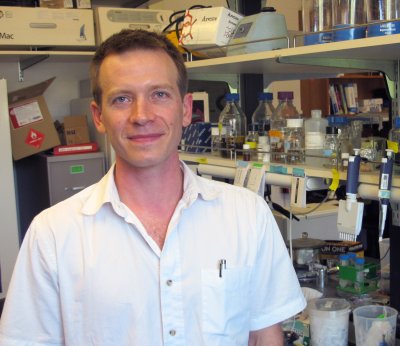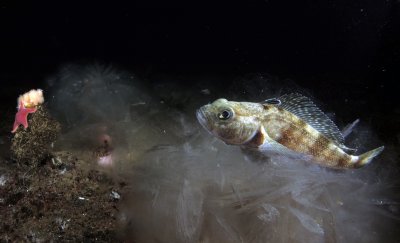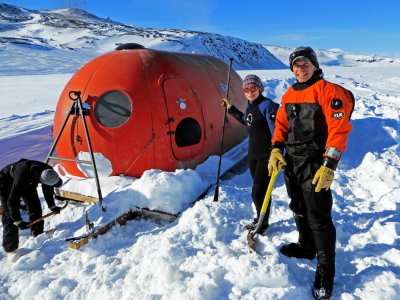University of Oregon doctoral student says the proteins needed to survive ice may have an evolutionary downside
 EUGENE, Ore. — Sept. 22, 2014 — Fish that adapted to survive and thrive in icy cold Antarctic waters by developing antifreeze proteins are swimming in an evolutionary paradox, says a University of Oregon researcher.
EUGENE, Ore. — Sept. 22, 2014 — Fish that adapted to survive and thrive in icy cold Antarctic waters by developing antifreeze proteins are swimming in an evolutionary paradox, says a University of Oregon researcher.
These life-saving proteins in Antarctic notothenioid [pronounced "NO-toe-thin-ee-oid"] fishes also prevent ice crystals inside the fishes from melting in warmer summer waters, reports Paul Cziko ["SEE-ko"], a doctoral student in the UO Institute of Ecology and Evolution. He is the lead author on a paper in this week's online Early Edition of the Proceedings of the National Academy of Sciences.
Co-author Arthur DeVries, professor emeritus of animal biology at the University of Illinois at Urbana-Champaign, discovered antifreeze proteins over 40 years ago while studying how these cold-loving fishes survive in conditions that would freeze most other fishes. He and colleagues ultimately found that the proteins help the fishes avoid freezing by binding to ice crystals that enter their bodies and preventing them from growing.
In an evolutionary twist, the researchers now report that this simple survival solution may be a double-edged sword.
AUDIO AND SLIDESHOW:
► Cziko provides a summary of the findings, 51 seconds
► Cziko tells how the findings fit into a bigger picture, 61 seconds
► See a University of Illinois slideshow with co-author Cheng for details on the long-running research at McMurdo Sound.
"We discovered what appears to be an undesirable consequence of the evolution of antifreeze proteins in Antarctic notothenioid fishes," Cziko said. "What we found is that the antifreeze proteins also stop internal ice crystals from melting. That is, they are anti-melt proteins, as well."
 The researchers found that when they warmed the fishes to temperatures above the expected melting point, some ice remained inside their bodies. Ice that doesn't melt in such conditions is defined as superheated.
The researchers found that when they warmed the fishes to temperatures above the expected melting point, some ice remained inside their bodies. Ice that doesn't melt in such conditions is defined as superheated.
Next, they tested wild fishes in Antarctica when the normally freezing seawater had warmed up somewhat during summer, and they found that ice remained inside these fishes as well.
In the lab, the team tested the antifreeze proteins and found that these essential proteins were also, paradoxically, responsible for this superheating effect.
"Our discovery may be the first example of ice superheating in nature,” said co-author Chi-Hing "Christina" Cheng, a professor of animal biology at the University of Illinois. In this case, the ice inside these fishes doesn't melt at temperatures at least 1 C (1.8 F) above its expected melting point.
 To see whether the fishes' internal ice could ever melt, Cziko, with the help of other scuba divers, placed and maintained temperature loggers in an icy fish habitat in one of the world's most southerly and frigid marine environments — McMurdo Sound, Antarctica. The unprecedented water-temperature record of 11 years at the site is equal to a half or whole lifespan of the fish species used in the study.
To see whether the fishes' internal ice could ever melt, Cziko, with the help of other scuba divers, placed and maintained temperature loggers in an icy fish habitat in one of the world's most southerly and frigid marine environments — McMurdo Sound, Antarctica. The unprecedented water-temperature record of 11 years at the site is equal to a half or whole lifespan of the fish species used in the study.
During that time period, water temperatures varied by just over 3 F and never reached temperatures that would overcome the antifreeze protein-induced ice superheating to completely eliminate ice from inside the fishes.
The researchers suspect that the resulting accumulation of ice inside the fish poses adverse physiological consequences. But, for now, they don't know what they may be.
If the fish are "destined to carry ice crystals around all their lives," Cheng said, it is conceivable that ice particles could obstruct small capillaries or trigger undesired inflammatory responses. Cziko likens the potential threat to dangers posed by asbestos in the lungs or blood clots in the brain. "Since much of the ice accumulates in the fishes' spleens, we think there may be a mechanism to clear the ice from the circulation," he said.
“This is just one more piece in the puzzle of how notothenioids came to dominate the ocean around Antarctica,” he said. "It also tells us something about evolution. That is, adaptation is a story of tradeoffs and compromise. Every good evolutionary innovation probably comes with some bad, unintended effects."
The study may contribute more than just an improved understanding of the challenges Antarctic fishes face in their harsh environment today.
"The long-term temperature record of McMurdo Sound produced in the study," Cheng said, "will prove to be of great importance and utility for the polar research community that is addressing organismal responses to climate change in this coldest of all marine environments."
♦ Charles Amsler, organisms & ecosystems program director in NSF's Division of Polar Programs:
"This long-standing and continuously refined work on the antifreeze properties of Antarctic fish exemplifies one of the best and defining features of good science. The researchers not only have for decades consistently produced new and exciting finds that contribute to our understanding of Antarctic ecosystems, but very often those new finds have led to new questions and deeper understandings across biology as a whole."
Clive W. Evans, a professor of molecular genetics and development at the University of Auckland in New Zealand, is also a co-author of the new paper.
Cziko's participation in the research was supported by a graduate research fellowship from the National Science Foundation. The overall project was supported by a grant (ANT 1142158) from the NSF's Division of Polar Programs. The Division manages the United States Antarctic Program, though which it coordinates all U.S. research on the southernmost continent and provides the logistical framework to support the science.
Media Contacts: Jim Barlow, director of science and research communications, 541-346-3481, jebarlow@uoregon.edu, or Diana Yates, life sciences editor, University of Illinois News Bureau, 217-333-5802; diya@illinois.edu
Sources: Paul Cziko, doctoral student, UO Institute of Ecology and Evolution, 217-819-7976, pcziko@uoregon.edu, and C-H Christina Cheng, associate professor, UI Department of Animal Biology, 217-333-2832, c-cheng@illinois.edu
Note: The University of Oregon is equipped with an on-campus television studio with a point-of-origin Vyvx connection, which provides broadcast-quality video to networks worldwide via fiber optic network. In addition, there is video access to satellite uplink, and audio access to an ISDN codec for broadcast-quality radio interviews.